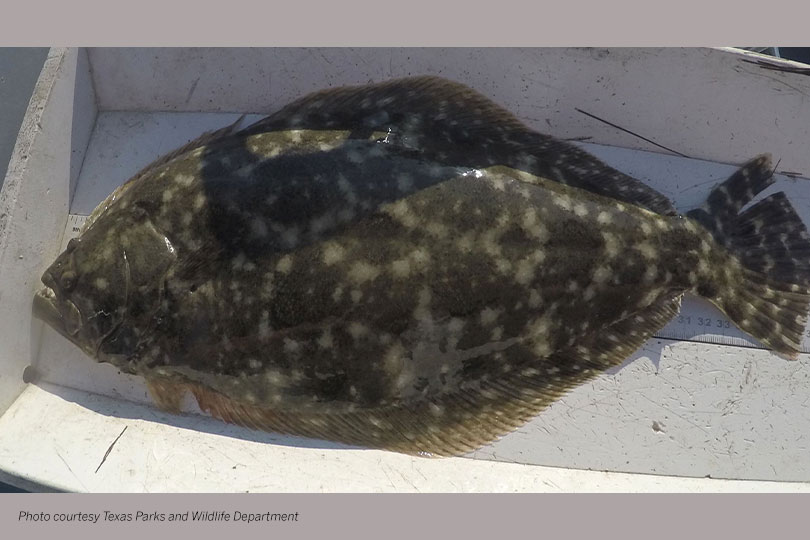By Jessica Domel
Multimedia Reporter
In an effort to better understand what’s causing Southern Flounder population declines, the Center for Sportfish Science and Conservation partnered with the Texas Parks and Wildlife Department (TPWD) to learn more about the flat fish, how it interacts with its environment and how anglers are catching them.
“We really do want angler input on this,” Quentin Hall, angler engagement coordinator and research specialist for the center, said. “As soon as we talk to anglers, we gain, as scientists, so much insight into what’s actually going on in the water. Every single person in our lab is an avid fisherman, but when you talk to these anglers that are out there 40-50 hours a week–guides and stuff like that–you get such a better handle on what the fishery’s actually doing.”
Basic research on Southern Flounder is needed because although they’re a popular catch, not much is known about the flat fish.
“There are so many unknowns about these fish because they don’t follow a classic life history model that we’re used to,” Hall said in an interview with the Texas Farm Bureau Radio Network. “Up until now, there really has not been a lot of focus on flounder because they’re not technically considered a sportfish on the state or federal level.”
Researchers are gathering data on flounder to figure out how they interact with their environment, what their young need to grow and survive and other basic information that was learned about other fish, like redfish and trout, decades ago while simultaneously trying to figure out why flounder populations are declining.
In the United States, Southern Flounder can be found from North Carolina down to the southern most tip of Texas and sometimes Northern Mexico.
Since the Texas coast is the very edge of their range, the flounder there are living in one of the more extreme environments that they’re able to survive in.
“On a daily basis, these fish are facing stressors that fish in Louisiana aren’t facing,” Hall said. “So inherently, we’ve always watched flounder a little bit more closely because–since they’re on the edge of their range–just a little change in the environment could be enough to really tip the population over.”
Just like in other parts of the Southern Flounder’s range, flounder populations here have been declining for years.
Unlike other fish that have massive body cavities to lay a good number of eggs each year, flounder are flat and unable to produce as many eggs to help their population bounce back.
“It’s no big deal for a redfish in Texas to produce 20 million eggs or more,” Hall said. “Flounder have evolved to lay flat as adults and be on the bottom. Their body cavities are very small. They have to stuff all their organs in this really tiny area. It doesn’t leave a lot of room for egg development during spawning season.”
Flounder may only lay around 300,000 eggs a year.
“Whenever there is a decrease in the population, redfish and trout are really able to kind of overcome those problems just by the number of eggs they’re capable of producing,” Hall said. “Flounder don’t really have that capability.”
In addition to gathering some basic information on flounder, the researchers will also study how many flounder are caught by anglers each year. For the next several months, they are meeting anglers at docks in the Coastal Bend to ask a few questions about their catch.
“There are rod and reel fisheries for them, particularly in places like Galveston, but flounder gigging is obviously a very culturally important part of Gulf Coast life. It’s something that a lot of people, myself included, do, but because it occurs at night, and most state surveys occur during the day, there’s very little, if any, information on how many fish are actually being harvested,” Hall said. “It’s very difficult for managers to figure out basically how many fish can be harvested from the population on a yearly basis because we don’t really know exactly how many are being taken.”
TPWD has been unable to monitor the nighttime fisheries for a number of reasons, including cost.
“With the fishery being in a long-term decline, they felt this is something we need to get a handle on at this point,” Hall said.
Hall noted the goal is not to take the ability to gig or fish for flounder away from anglers.
“We’re trying to figure out what’s going on in the fishery because if it keeps going the way that it is, there are not going to be flounder around for much longer,” Hall said. “At that point, the fishery will go away on its own. We really are just encouraging people to come and talk to us, help us get a handle on what’s going on so that we can help advise (TPWD) on what we think the issues might be.”
The researchers will not be writing tickets or reporting anglers for their catch.
“The Sportfish Center is literally just there to collect data to try to figure out what the situation is,” Hall said. “Our goal is for flounder to be around for our kids, grandkids and great grandkids to utilize and enjoy the same way we do.”
The nighttime flounder surveys will take place through next year.

